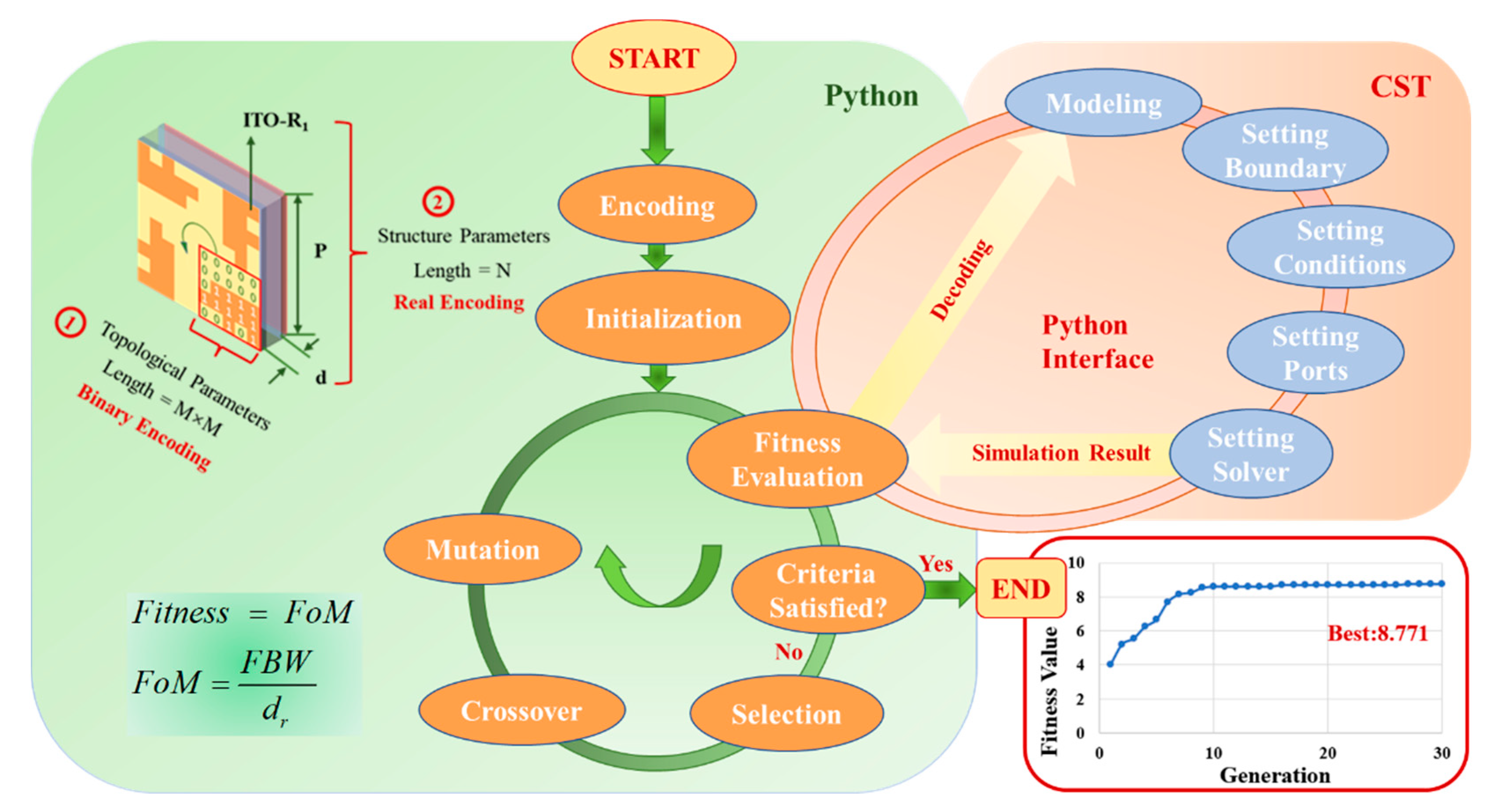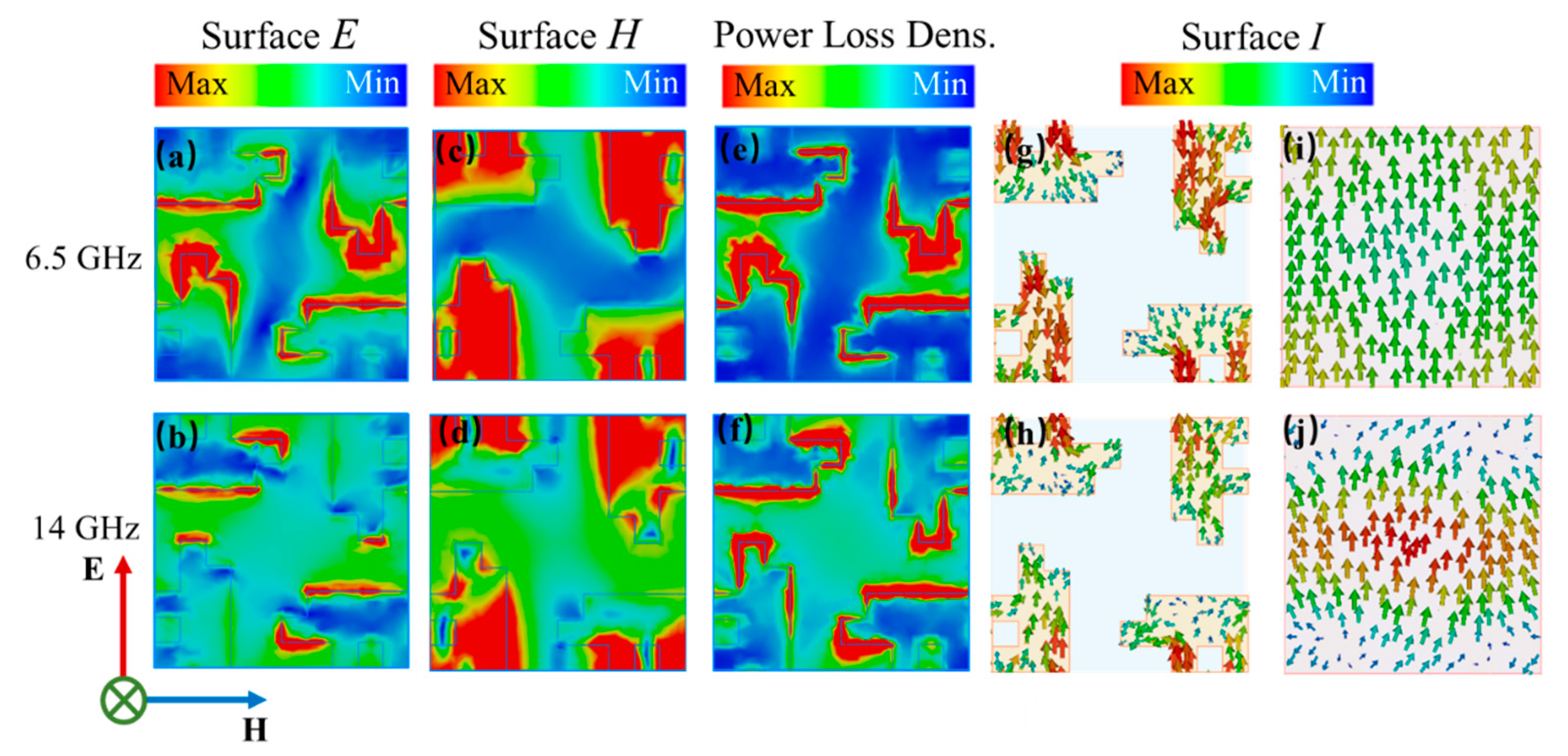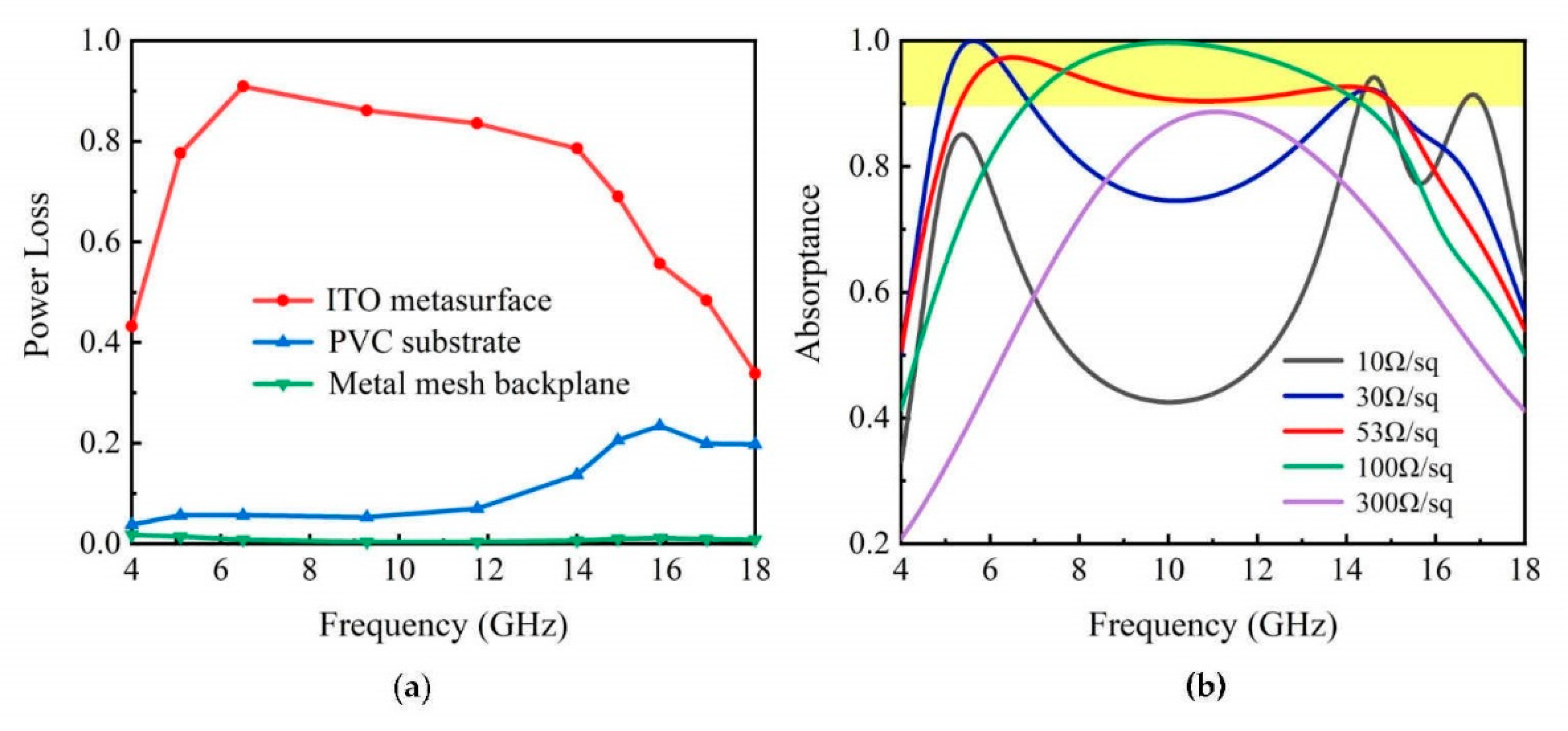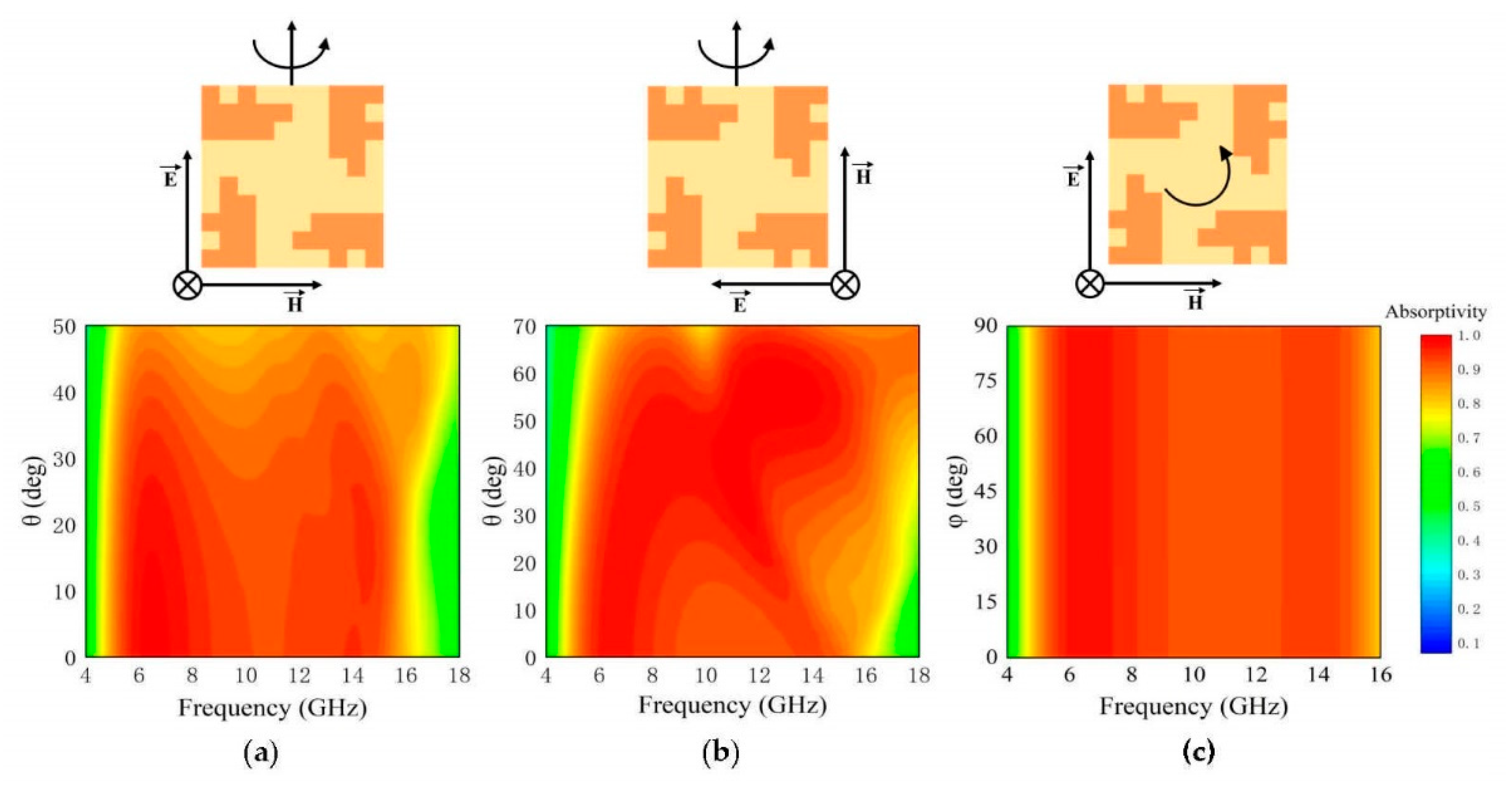Optically Transparent Flexible Broadband Metamaterial Absorber Based on Topology Optimization Design
Abstract
:1. Introduction
2. Unit Cell Design by Topology Optimization
3. Simulation and Analysis
4. Experiment and Discussion
5. Conclusions
Author Contributions
Funding
Conflicts of Interest
References
- Xiao, P.S.; Yi, N.B.; Zhang, T.F.; Huang, Y.; Chang, H.C.; Yang, Y.; Zhou, Y.; Chen, Y.S. Construction of a Fish-like Robot Based on High Performance Graphene/PVDF Bimorph Actuation Materials. Adv. Sci. Lett. 2016, 3, 1500438. [Google Scholar] [CrossRef]
- Fallahi, A.; Yahaghi, A.; Benedickter, H.R.; Abiri, H.; Shahabadi, M.; Hafner, C. Thin Wideband Radar Absorbers. IEEE Trans. Antennas Propag. 2010, 58, 4051–4058. [Google Scholar] [CrossRef]
- Ra’di, Y.; Simovski, C.R.; Tretyakov, S.A. Thin Perfect Absorbers for Electromagnetic Waves: Theory, Design, and Realizations. Phys. Rev. Appl. 2015, 3, 037001. [Google Scholar] [CrossRef]
- McFarland, E.W.; Tang, J. A photovoltaic device structure based on internal electron emission. Nature 2003, 421, 616–618. [Google Scholar] [CrossRef] [PubMed]
- Jung, J.; Park, H.; Park, J.; Chang, T.; Shin, J. Broadband metamaterials and metasurfaces: A review from the perspectives of materials and devices. Nanophotonics 2020, 9, 3165–3196. [Google Scholar] [CrossRef]
- Hogan, N.J.; Urban, A.S.; Ayala-Orozco, C.; Pimpinelli, A.; Nordlander, P.; Halas, N.J. Nanoparticles Heat through Light Localization. Nano Lett. 2014, 14, 4640–4645. [Google Scholar] [CrossRef] [PubMed] [Green Version]
- Deng, R.; Zhang, K.; Li, M.; Song, L.; Zhang, T. Targeted design, analysis and experimental characterization of flexible microwave absorber for window application. Mater. Des. 2019, 162, 119–129. [Google Scholar] [CrossRef]
- Hu, D.; Cao, J.; Li, W.; Zhang, C.; Wu, T.; Li, Q.; Chen, Z.; Wang, Y.; Guan, J. Optically Transparent Broadband Microwave Absorption Metamaterial By Standing-Up Closed-Ring Resonators. Adv. Opt. Mater. 2017, 5, 1700109. [Google Scholar] [CrossRef]
- Stergiou, C.A.; Litsardakis, G. Y-type hexagonal ferrites for microwave absorber and antenna applications. J. Magn. Magn. Mater. 2016, 405, 54–61. [Google Scholar] [CrossRef]
- Ren, F.; Zhu, G.M.; Ren, P.G.; Wang, K.; Cui, X.P.; Yan, X.G. Cyanate ester resin filled with graphene nanosheets and CoFe2O4 reduced graphene oxide nanohybrids as a microwave absorber. Appl. Surf. Sci. 2015, 351, 40–47. [Google Scholar] [CrossRef]
- Kundu, D.; Baghel, S.; Mohan, A.; Chakrabarty, A. Design and Analysis of Printed Lossy Capacitive Surface-Based Ultrawideband Low-Profile Absorber. IEEE Trans. Antennas Propag. 2019, 67, 3533–3538. [Google Scholar] [CrossRef]
- Okano, Y.; Ogino, S.; Ishikawa, K. Development of Optically Transparent Ultrathin Microwave Absorber for Ultrahigh-Frequency RF Identification System. IEEE Trans. Microwave Theory Tech. 2012, 60, 2456–2464. [Google Scholar] [CrossRef]
- Kurihara, H.; Hirai, Y.; Takizawa, K.; Iwata, T.; Hashimoto, O. An improvement of communication environment for ETC system by using transparent EM wave absorber. IEICE Trans. Electron. 2005, E88c, 2350–2357. [Google Scholar] [CrossRef]
- Kong, X.K.; Jiang, S.L.; Kong, L.Q.; Wang, Q.; Hu, H.B.; Zhang, X.; Zhao, X. Transparent metamaterial absorber with broadband radar cross-section (RCS) reduction for solar arrays. IET Microw. Antennas Propag. 2020, 14, 1580–1586. [Google Scholar] [CrossRef]
- Pang, Y.; Shen, Y.; Li, Y.; Wang, J.; Xu, Z.; Qu, S. Water-based metamaterial absorbers for optical transparency and broadband microwave absorption. J. Appl. Phys. 2018, 123, 155106. [Google Scholar] [CrossRef]
- Shen, Y.; Zhang, J.; Pang, Y.; Wang, J.; Ma, H.; Qu, S. Transparent broadband metamaterial absorber enhanced by water-substrate incorporation. Opt. Express 2018, 26, 15665–15674. [Google Scholar] [CrossRef] [PubMed]
- Jang, T.; Youn, H.; Shin, Y.J.; Guo, L.J. Transparent and Flexible Polarization-Independent Microwave Broadband Absorber. ACS Photonics 2014, 1, 279–284. [Google Scholar] [CrossRef]
- Zheng, Y.; Chen, K.; Jiang, T.; Zhao, J.; Feng, Y. Multi-octave microwave absorption via conformal metamaterial absorber with optical transparency. J. Phys. D Appl. Phys. 2019, 52, 335101. [Google Scholar] [CrossRef]
- Sheokand, H.; Singh, G.; Ghosh, S.; Ramkumar, J.; Ramakrishna, S.A.; Srivastava, K.V. An Optically Transparent Broadband Microwave Absorber Using Interdigital Capacitance. IEEE Antennas Wirel. Propag. Lett. 2019, 18, 113–117. [Google Scholar] [CrossRef]
- Li, T.; Chen, K.; Ding, G.; Zhao, J.; Jiang, T.; Feng, Y. Optically transparent metasurface Salisbury screen with wideband microwave absorption. Opt. Express 2018, 26, 34384–34395. [Google Scholar] [CrossRef]
- Grande, M.; Bianco, G.V.; Vincenti, M.A.; de Ceglia, D.; Capezzuto, P.; Petruzzelli, V.; Scalora, M.; Bruno, G.; D‘Orazio, A. Optically transparent microwave screens based on engineered graphene layers. Opt. Express 2016, 24, 22788–22795. [Google Scholar] [CrossRef] [PubMed] [Green Version]
- Fante, R.L.; Mccormack, M.T. Reflection Properties of the Salisbury Screen. IEEE Trans. Antennas Propag. 1988, 36, 1443–1454. [Google Scholar] [CrossRef]
- Dutoit, L.J. The Design of Jauman Absorbers. IEEE Antennas Propag. Mag. 1994, 36, 17–25. [Google Scholar] [CrossRef]
- Yi, D.; Wei, X.-C.; Xu, Y.-L. Tunable Microwave Absorber Based on Patterned Graphene. IEEE Trans. Microw. Theory Tech. 2017, 65, 2819–2826. [Google Scholar] [CrossRef]
- Watts, C.M.; Liu, X.; Padilla, W.J. Metamaterial electromagnetic wave absorbers. Adv. Mater. 2012, 24, OP98–OP120. [Google Scholar] [CrossRef] [PubMed]
- Wang, Y.-Z.; Xu, H.-X.; Wang, C.-H.; Wang, M.-Z.; Wang, S.-J. Research progress of electromagnetic metamaterial absorbers. Acta Physica Sinica 2020, 69, 134101. [Google Scholar] [CrossRef]
- Asadchy, V.S.; Faniayeu, I.A.; Ra’di, Y.; Khakhomov, S.A.; Semchenko, I.V.; Tretyakov, S.A. Broadband Reflectionless Metasheets: Frequency-Selective Transmission and Perfect Absorption. Phys. Rev. X 2015, 5, 031005. [Google Scholar] [CrossRef]
- Imani, M.F.; Smith, D.R.; del Hougne, P. Perfect Absorption in a Disordered Medium with Programmable Meta-Atom Inclusions. Adv. Funct. Mater. 2020, 30, 2005310. [Google Scholar] [CrossRef]
- Landy, N.I.; Sajuyigbe, S.; Mock, J.J.; Smith, D.R.; Padilla, W.J. Perfect metamaterial absorber. Phys. Rev. Lett. 2008, 100, 207402. [Google Scholar] [CrossRef]
- Xiao, H.D.; Qin, R.R.; Lv, M.Y.; Wang, C.Z. Highly Transparent Broadband and Polarization-Insensitive Absorber Based on Metasurface. Appl. Sci. 2020, 10, 9125. [Google Scholar] [CrossRef]
- Li, L.; Xi, R.; Liu, H.X.; Lv, Z.Y. Broadband polarization-independent and low-profile optically transparent metamaterial absorber. Appl. Phys. Express 2018, 11, 052001. [Google Scholar] [CrossRef]
- Deng, G.S.; Lv, K.; Sun, H.X.; Yang, J.; Yin, Z.P.; Chi, B.H.; Li, X.X. An ultra-broadband and optically transparent metamaterial absorber based on multilayer indium-tin-oxide structure. J. Phys. D Appl. Phys. 2021, 54, 165301. [Google Scholar] [CrossRef]
- Deng, R.X.; Li, M.L.; Muneer, B.; Zhu, Q.; Shi, Z.Y.; Song, L.X.; Zhang, T. Theoretical Analysis and Design of Ultrathin Broadband Optically Transparent Microwave Metamaterial Absorbers. Materials 2018, 11, 107. [Google Scholar] [CrossRef] [Green Version]
- Min, P.; Song, Z.; Yang, L.; Dai, B.; Zhu, J. Transparent ultrawideband absorber based on simple patterned resistive metasurface with three resonant modes. Opt. Express 2020, 28, 19518–19530. [Google Scholar] [CrossRef]
- Zhang, C.; Cheng, Q.; Yang, J.; Zhao, J.; Cui, T.J. Broadband metamaterial for optical transparency and microwave absorption. Appl. Phys. Lett. 2017, 110, 143511. [Google Scholar] [CrossRef]
- Zhao, Y.; Li, S.; Jiang, Y.; Gu, C.; Liu, L.; Li, Z. An ultra-wideband and wide-angle optically transparent flexible microwave metamaterial absorber. J. Phys. D Appl. Phys. 2021, 54, 275101. [Google Scholar] [CrossRef]
- Sui, S.; Ma, H.; Wang, J.; Pang, Y.; Qu, S. Topology optimization design of a lightweight ultra-broadband wide-angle resistance frequency selective surface absorber. J. Phys. D Appl. Phys. 2015, 48, 215101. [Google Scholar] [CrossRef] [Green Version]
- Sui, S.; Ma, H.; Wang, J.; Pang, Y.; Feng, M.; Xu, Z.; Qu, S. Absorptive coding metasurface for further radar cross section reduction. J. Phys. D Appl. Phys. 2018, 51, 065603. [Google Scholar] [CrossRef]
- Zhao, J.; Zhang, C.; Cheng, Q.; Yang, J.; Cui, T.J. An optically transparent metasurface for broadband microwave antireflection. Appl. Phys. Lett. 2018, 112, 073504. [Google Scholar] [CrossRef]
- Fano, R.M. Theoretical Limitations of the Broadband Matching of Arbitrary Impedances. J. Frankl. Inst. 2005, 249, 57–83. [Google Scholar] [CrossRef] [Green Version]
- Smith, D.R.; Vier, D.C.; Koschny, T.; Soukoulis, C.M. Electromagnetic parameter retrieval from inhomogeneous metamaterials. Phys. Rev. E Stat. Nonlin. Soft Matter Phys. 2005, 71, 036617. [Google Scholar] [CrossRef] [PubMed] [Green Version]
- Ziolkowski, R.W. Design, fabrication, and testing of double negative metamaterials. IEEE Trans. Antennas Propag. 2003, 51, 1516–1529. [Google Scholar] [CrossRef]
- Chen, K.; Cui, L.; Feng, Y.; Zhao, J.; Jiang, T.; Zhu, B. Coding metasurface for broadband microwave scattering reduction with optical transparency. Opt. Express 2017, 25, 5571–5579. [Google Scholar] [CrossRef]
- Chen, X.L.; Nie, S.H.; Guo, W.R.; Fei, F.; Su, W.M.; Gu, W.B.; Cui, Z. Printable High-Aspect Ratio and High-Resolution Cu Grid Flexible Transparent Conductive Film with Figure of Merit over 80,000. Adv. Electron. Mater. 2019, 5, 1800991. [Google Scholar] [CrossRef]
- Zhang, C.; Yang, J.; Cao, W.; Yuan, W.; Ke, J.; Yang, L.; Cheng, Q.; Cui, T. Transparently curved metamaterial with broadband millimeter wave absorption. Photonics Res. 2019, 7, 478–485. [Google Scholar] [CrossRef]








| Absorber Structure | Relative Thickness (λL) 1 | 90% Absorption Bandwidth (GHz) | FBW | Flexible | FoM |
|---|---|---|---|---|---|
| [35] | 0.145 | 8.3–14.7 | 70.8% | NO | 4.425 |
| [17] | 0.142 | 5.8–12.2 | 71.1% | YES | 5.007 |
| [7] | 0.137 | 6–15.6 | 88.9% | YES | 6.489 |
| [45] | 0.178 | 26.5–40 | 40.6% | YES | 2.281 |
| This work | 0.109 | 5.3–15 | 95.6% | YES | 8.771 |
| Acronym | Meaning/Full Form |
|---|---|
| FTBMA | Flexible Transparent Broadband Metamaterial Absorber |
| GA | Genetic Algorithm |
| FBW | Fractional Bandwidth |
| FoM | Figure of Merit |
| RFID | Radio Frequency Identification |
| ETC | Electronic Toll Collection |
| ITO | Indium Tin Oxid |
| PMMA | Polymethyl Methacrylate |
| PVC | Polyvinyl Chloride |
| PET | Polyethylene Terephthalate |
| CST MWS | Computer Simulation Technology Microwave Studio |
| TE | Transverse Electric |
| TM | Transverse Magnetic |
| PBCs | Periodic Boundary Conditions |
Publisher’s Note: MDPI stays neutral with regard to jurisdictional claims in published maps and institutional affiliations. |
© 2021 by the authors. Licensee MDPI, Basel, Switzerland. This article is an open access article distributed under the terms and conditions of the Creative Commons Attribution (CC BY) license (https://creativecommons.org/licenses/by/4.0/).
Share and Cite
Min, P.; Song, Z.; Yang, L.; Ralchenko, V.G.; Zhu, J. Optically Transparent Flexible Broadband Metamaterial Absorber Based on Topology Optimization Design. Micromachines 2021, 12, 1419. https://doi.org/10.3390/mi12111419
Min P, Song Z, Yang L, Ralchenko VG, Zhu J. Optically Transparent Flexible Broadband Metamaterial Absorber Based on Topology Optimization Design. Micromachines. 2021; 12(11):1419. https://doi.org/10.3390/mi12111419
Chicago/Turabian StyleMin, Pingping, Zicheng Song, Lei Yang, Victor G. Ralchenko, and Jiaqi Zhu. 2021. "Optically Transparent Flexible Broadband Metamaterial Absorber Based on Topology Optimization Design" Micromachines 12, no. 11: 1419. https://doi.org/10.3390/mi12111419
APA StyleMin, P., Song, Z., Yang, L., Ralchenko, V. G., & Zhu, J. (2021). Optically Transparent Flexible Broadband Metamaterial Absorber Based on Topology Optimization Design. Micromachines, 12(11), 1419. https://doi.org/10.3390/mi12111419







